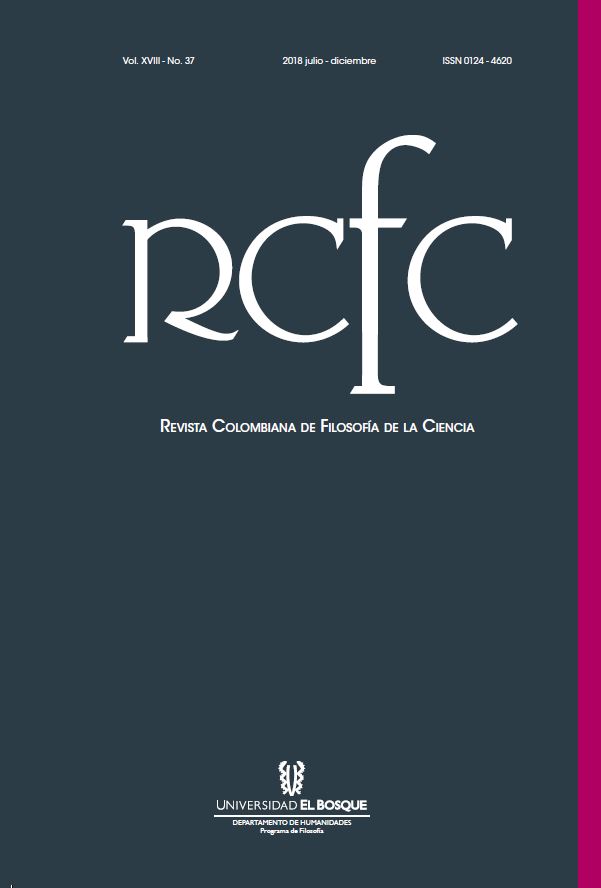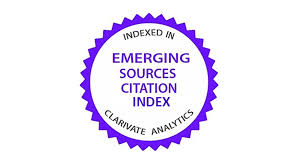Integration of Analogies in Scientific Modeling
DOI:
https://doi.org/10.18270/rcfc.v18i37.2580Keywords:
Modeling, Scientific Representation, Analogy, Nervous Impulse, Hodgkin And Huxley ModelAbstract
Discussion of modeling within philosophy of science has focused in how models, understood as finished products, represent the world. This approach has some issues accounting for the value of modeling in situations where there are controversies as to which should be the object of representation. In this work I show that a historical analysis of modeling complements the aforementioned representational program, since it allows us to examine processes of integration of analogies that play a role in the generation of criteria of relevance, which are important for the configuration of the object of research. This, in turn, shows that there are norms in modeling practices whose historical reconstruction is relevant for their philosophical analysis.
Downloads
References
B. C. Abbott, A. V. Hill, y J. V. Howarth. “The Positive and Negative Heat Production Associated with a Nerve Impulse.” Proceedings of the Royal Society B: Biological Sciences 148.931 (1958): 149–87. <https://doi.org/10.1098/rspb.1958.0012>.
Cole, Kenneth, S. “Rectification and Inductance in the Squid Gian Axon”. The Journal of General Physiology 25.1 (1941): 29–51. <10.1085/jgp.25.1.29 >.
Gelfert, Axel. How to Do Science with Models. Springer, 2016. <https://doi.org/10.1007/978-3-319-27954-1>.
Godfrey-Smith, Peter. “Abstractions, Idealizations, and Evolutionary Biology”. Mapping the Future of Biology. Springer Netherlands, 2018. 47–56.
Hille, Bertil. Ionic Channels of Excitable Membranes. Second Edition. Sinauer Associates, 1992.
Hodgkin, A. L. “The Croonian Lecture: Ionic Movements and Electrical Activity in Giant Nerve Fibres”. Proceedings of the Royal Society B: Biological Sciences 148.930 (1958): 1–37.
Hodgkin, A. L. The Conduction of the Nervous Impulse. The Sherrington Lectures, Charles C Thomas, 1964.
Hodgkin, A. L., y Andrew F. Huxley. “The Components of Membrane Conductance in the Giant Axon of Loligo A”. The Journal of Physiology 116.4 (1952a): 473–96.
______. “A Quantitative Description of Membrane Current and Its Application to Conduction and Excitation in Nerve”. The Journal of Physiology 117.4 (1952b): 500–44.
Knuuttila, Tarja. “Modelling and Representing: An Artefactual Approach to Model-Based Representation”. Studies in History and Philosophy of Science Part A 42.2 (2011): 262–71.
Levy, Arnon. “Idealization and Abstraction: Refining the Distinction”. Synthese 1.1 (2018): 1–18.
Lillie, Ralph S. “The Passive Iron Wire Model of Protoplasmic and Nervous Transmission and its Physiological Analogues”. Biological Reviews 11.2 (1936): 181–209.
Meares, Patrick. “Flux Coupling and Nonlinear Membrane Phenomena”. Structure and Funciton in Excitable Cells. Eds. Chang, Donald C, Ichiji Tasaki, William J. Adelman y H R. Leuchtag. Plenum Press, 1983.
Massimi, Michela. “Perspectival Modeling”. Philosophy of Science 85.3 (2018) 335–359.
Mosgaard, Lars D., Zecchi K.A., Heimburg T. y Budvytyte R. “The Effect of the Nonlinearity of the Response of Lipid Membranes to Voltage Perturbations on the Interpretation of Their Electrical Properties. A New Theoretical Description”. Membranes 5.4 (2015): 495–512.
Peschard, Isabelle. “Target Systems, Phenomena and the Problem of Relevance”. The Modern Schoolman 87.3 (2010): 267.
Sanches de Oliveira, Guilherme. “Approaches to Scientific Modeling, and the (Non) Issue of Representation: A Case Study in Multi-Model Research on Thigmotaxis and Group Thermoregulation”. Model-Based Reasoning in Science and Technology. Eds. Lorenzo Magnani y Claudia Casadio. Springer, 2016. 79–100.
Seyfarth, Ernst-August und Leo Peichl. “Vor 100 Jahren: Julius Bernstein (1839-1917) Formuliert Seine Membrantheorie”. Neuroforum 4.2 (2002): 274–76
Tasaki, Ichiji. Physiology and Electrochemistry Nerve Fibers. Academic Press, 1982.
Tasaki, Ichiji, y Kunihiko Iwasa. “Rapid Pressure Changes and Surface Displacements in the Squid Giant Axon Associated with Production of Action Potentials”. Japanese Journal of Physiology 32.1 (1982): 69–81.
Teorell, Torsten. “Excitability Phenomena in Artificial Membranes”. Biophysical Journal 2.2 (1962): 25–51.
Weisberg, Michael. Simulation and Similarity: Using Models to Understand the World. New York: Oxford University Press, 2013.
Downloads
Published
How to Cite
Issue
Section
| Article metrics | |
|---|---|
| Abstract views | |
| Galley vies | |
| PDF Views | |
| HTML views | |
| Other views | |












